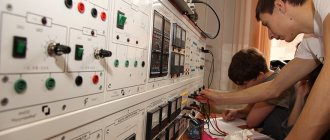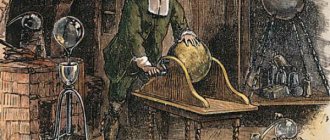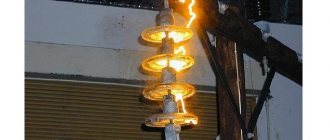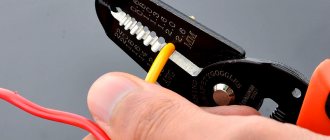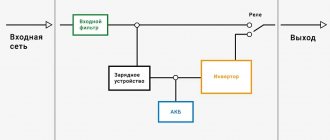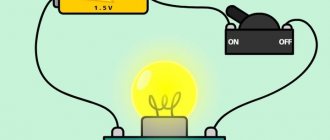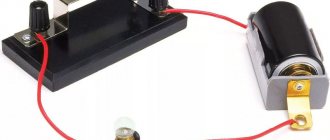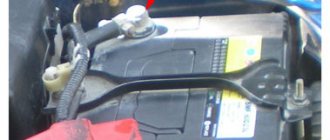VRU, ShchO, ShchE - these and many other designations (abbreviations) found on electrical panels can hardly explain anything to the average consumer. But those who are just starting their journey in the complex but interesting electrical industry need to know the purposes and designations of the main types of switchboards.
It is logical to start an educational program on electrical panels with the panel that is highest in the hierarchy of electricity distribution.
Main distribution board (MSB)
The main distribution board (MSB), as a rule, is located at transformer substations, various boiler houses, etc. That is, it cannot be seen in a residential building - a power line comes to your house, which departs from the MSB. It is used for inputting high-power power lines, metering electrical energy, and distributing power along outgoing lines of downstream facilities. Also, the concept of main switchboard began to be applied to high-power electrical inputs (for currents of several thousand amperes).
Input switchgear (IDU)
This shield is a device containing devices for protecting outgoing load lines, devices for measuring and accounting for general house electricity, which can also include relatively simple automation. The main supply cable to the ASU, as a rule, comes from the main switchboard, and already inside the input switchgear itself, the electricity is distributed along outgoing lines, each of which has its own purpose. Typically, ASUs are installed at the entrance to residential buildings and public buildings, as well as in the workshops of industrial enterprises or factories. The place where ASUs are installed in residential and public buildings is most often the basement. Next, along lines protected by circuit breakers or fuses, the electricity is sent to electrical panels, which we will look at below.
Unified wire marking standards
It is not by chance that conductors are designated by different colors. There is a single standard for marking all conductors. These standards are described by PTEEP, which stands for “Rules for the technical operation of consumer electrical installations.”
These rules describe that the cores of all conductors must be marked with certain colors, alphabetic or numerical symbols. In addition, the shield must also be marked in a special way.
Electrical installation rules regulate the following:
- The electrical panel must have a name, that is, a designation on a visible part of the housing. If the shield is located inside the house, it does not need to be marked, since it is already clear what kind of structure it is. But if it is located, for example, on a support on the street, there must be markings.
- During the installation of the shield, you will need to leave a diagram or sheet inside where energy consumers and electrical points will be indicated. So, groups of sockets and a lighting group can be marked there.
- The input panel diagram should also be placed in the panel. This regulation applies to devices that were purchased already assembled.
It happens that the panel is assembled not by you, but by an electrician. In this case, you need to take from the master the diagram according to which he assembled this part of the wiring.
There are other points in the Electrical Installation Rules that you need to know about:
- In the second chapter of the Electrical Installation Rules it is written that all cable lines must have a number or name.
- In the second chapter of the Consumer Operating Rules it is written that all cables that are laid openly must have tags.
- On circuit breakers and on information stands there must be marking elements related to the difference between groups of electrical wiring. According to the rules, there must be a number and room for which the kitchen is intended. For example, this could be a group for the living room, kitchen and other rooms.
- All switchboards and electrical cabinets must have a passport in which all necessary parts of the marking must be indicated. This will be an indispensable help if there is no place inside the cabinet to write down markings.
The state standard also includes some rules. Among the GOST rules we highlight the following:
- According to the standard, marking of conductors should be done using tags or PVC tapes. Heat shrink and PVC tubing can be excellent replacement tags.
- It is necessary to mark the markings in legible handwriting so that anyone can understand the designation. The tag should not be less than twenty-five millimeters in length.
- Marking can be applied to the insulating layer of conductors. We must not forget that the marking must be located in a visible place.
These were the key standards regarding the markings of conductors in the panel. We will tell you in more detail about what can be used for marking.
Floor board (SHE)
From the input switchgear, electricity distribution lines (or, as they are also called, “risers”) go to the floor panels. The latter are used to account for electricity and protect lines going to apartments. Most often, in a floor panel, electricity metering and distribution is carried out for 4 apartments, but there are also switchboards for 6 apartments. For example, if you did not repair or replace the wiring, then most likely the circuit breakers that protect your apartment from short-circuit currents. and overloads are located in the floor panel. People who have replaced outdated wiring with a new one that meets modern regulatory requirements, as a rule, organize the apartment’s power supply system in the most convenient way for themselves: they increase the number of groups, organize separate protection for the lines of “light” and “socket” loads. Such a modernization of the apartment’s power supply system implies the creation of one’s own apartment panel, which will be discussed in the next paragraph of the article.
Marking of electrical cabinets. Ready-made BRADY solutions
Markings from the BRADY company are modern and reliable products that are convenient and easy to attach, do not wear out over time, are durable and excellent readability. The article presents only some of the BRADY products launched on the Russian market: BBP12 printer, EPREP labels, pre-cut heat-shrink tubing, self-laminating markers, etc.
CJSC "UNIT MARK PRO", Moscow
BRADY Corporation is the founder of industrial marking in the electrical industry. In the 40s of the last century, the BRADY cable marking was already used by the US aviation industry to identify cables and wires on aircraft. Over the past decades, the company has developed and successfully implemented hundreds of types of marking solutions and is rightfully considered one of the leaders in the production of products and identification solutions in the industry.
Modern ready-made BRADY solutions are a big step forward compared to traditional methods. Until now, production uses markings made by hand or in the cheapest possible printing way. Obvious weaknesses of this method: markings wear out very quickly, fade, do not withstand exposure to external environments and become unreadable. And if the marking cannot be read, why is it needed?
Rice. 1.
Electrical cabinet assembly
To create markings for electrical cabinets, BRADY offers one of the most relevant and reliable technologies at the moment - thermal transfer printing. The application of the required symbols on the label occurs through the point-by-point fusion of a resin-based coloring composition into the label material to a depth of several microns. The result is a clear, easily readable label that is resistant to external influences and virtually resistant to abrasion.
Fast and high-quality printing of labels for external and internal marking of electrical cabinets is provided by the BRADY BBP12 label printer. The BBP12 thermal transfer printer can work with different materials and allows you to print all types of markings for electrical cabinets. One of the most popular solutions has become polyester labels on a polyethylene foam base - EPREP (Fig. 2).
Rice. 2.
EPREP polyester labels stick to any surface
This material, like all BRADY materials, is resistant to smudging, scratches, ultraviolet rays, alcohol and diesel fuel. And the reinforced acrylic adhesive ideally attaches to any surface, including those painted with powder technologies (shagreen). EPREP material is used to print nameplates up to 100 x 50 mm (an excellent alternative to metal nameplates) and overlays/inserts for marking buttons and signal lamps.
Inside the electrical panel, marking of switching elements and cable and wire products is required. BRADY offers a wide range of polyester labels in a variety of colors (including reinforced adhesive for use on uneven powder coated surfaces). The pre-cut BRADY heat-shrinkable tube (Fig. 3) solves three problems at once: marking, electrical insulation and protection from the external environment. And BRADY heat-shrinkable tubing is flame retardant.
Rice. 3.
Pre-cut BRADY Heat Shrink Tubing
An excellent solution for marking wires and cables would be self-laminating vinyl-based markers (Fig. 4). The label consists of two parts: the first, opaque, is where the required marking is applied, and the second, transparent, is wrapped around the wire/cable during installation and reliably protects the marking. Self-laminating markers are exceptionally durable and easy to read, even after many years.
Rice. 4.
Self-laminating vinyl labels from BRADY
You can print all of the above identification tools yourself on the same BBP12 printer in any quantity. You no longer depend on deadlines and minimum quantities when ordering markings from third-party manufacturers. To print circuit diagrams in A4 format, you can use ELAT material (Fig. 5) from BRADY - this is a color industrial polyester for printing on a regular office laser printer.
Rice. 5.
Circuit printed on industrial ELAT polyester
Using a ready-made BRADY solution for labeling electrical cabinets based on the BBP12 label printer, you get durable, sustainable labeling. All you need to do is purchase consumables on time and monitor the condition of the printer. The use of modern technologies has made it possible to increase the resource of the print head of the BBP12 printer to 25 km, which allows it to be classified as an industrial printer for medium-scale printing.
The BBP12 label printer is very easy to use: simple three-step calibration, simple installation of new materials and ribbon. Labeling electrical cabinets with BBP12 is one of the best ready-made solutions in the industry. To create and print labels, we recommend proprietary software CodeSoft 2015. The program is fully Russified, supports serialization of labels and downloading files from external sources (Excel, 1 C, etc.).
High-quality materials, innovative printing technologies and regular testing of its own products for durability - it is not for nothing that BRADY is considered one of the leaders in the production of products and solutions for identification at industrial facilities. The marking of BRADY electrical cabinets is really very convenient in production and installation and will last for many years. This is a solution for those who value the efficiency of their own work.
A ready-made marking solution for electrical cabinets will help you choose. Since 1998, YMP has been supplying BRADY products to Russia and the CIS countries, and has extensive experience in introducing labeling into production. BRADY equipment and consumables from UNIT MARK PRO mean stable supplies from a reliable company, service and repairs.
Not only is it ready to solve the problem of marking an electrical cabinet, it will provide production with the necessary tools. YMP offers a large selection of cable lugs and tools from the German company KLAUKE, tools for working with WEICON cables, and devices for perforating metal GREENLEE. And of course, here you will be offered a wide range of BRADY industrial printers: portable and stationary.
The article was published in the journal “ISUP”, No. 2(62)_2016
JSC "UNIT MARK PRO", Moscow, tel.: +7 (495) 748-0907, e-mail, www.umpgroup.ru
Apartment panel (SchK)
As already noted in one of the previous articles, there are several basic electrical diagrams of apartment panels. They can be combined with each other in various ways, tailoring the scheme specifically to your goals and objectives. The photograph shows the most preferred power supply scheme for an apartment: RCBOs installed in the switchboard not only protect a person from electric shock, but also protect the wiring from short-circuit currents. and overloads, but also save space in the apartment panel.
Emergency switchboard (ESB)
ShchAP boards (as well as AVR boards) are designed to automatically switch to a backup load power source in the event of a power failure and to return the electrical circuit to its original state when a normal voltage value is established in the network. Panels of this type can only be found at facilities where an uninterrupted supply of electrical receivers is required.
Control cabinet (CC)
The control room is used to control the automation of such systems as lighting, ventilation, fire alarms, heating and others. The parameters are set manually, and the state of the circuit and its individual elements is informatively displayed for personnel using light indicators.
The electrical panels and cabinets discussed in the article are the most common, but this is not a complete list of all existing electrical panels. There are shields that can be used to solve more specific problems, but this is not of great interest to a wide range of readers.
Shield marking - mandatory requirements
Applying markings - special designations created according to certain rules regulated by the requirements of GOST, TU and PUE. Marking the electrical panel is a mandatory operation during the production and assembly of products in St. Petersburg and Leningrad Region. This designation method is useful information for the user, helping to quickly identify consumer groups (lighting, sockets, household appliances). If it is necessary to turn on or turn off the consumer, you can easily find the required machine.
Marking the panel is necessary during the operation and maintenance of the electrical system, usually with the involvement of various repair and maintenance personnel.


